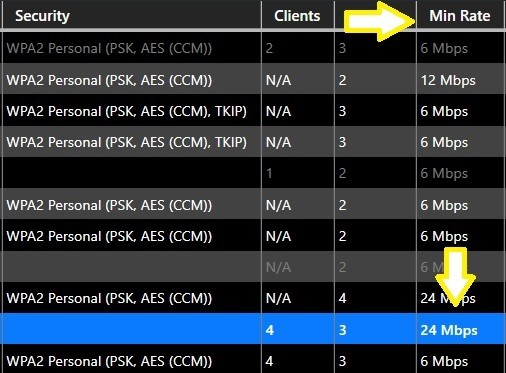The minimum basic rate, or Min Rate in WiFi Scanner, helps with access control, network efficiency, and throughput
Configuring the minimum rates in a WLAN can have many benefits to your network’s performance including reduction of management overhead, better airtime utilization, and enhanced throughput. It is an especially useful tool in High-Density scenarios like big office space, large lecture theatres, and any other environment with many clients in a relatively small space.
WLANs work using the IEEE 802.11 standard and its amendments. Some of these amendments are known as PHY specifications and define the modulation and coding of Wi-Fi signals that WLAN stations can use to communicate with each other. The table below summarises the available data rates of each 802.11 PHY specification:
|
PHY SPECIFICATION |
802.11 Amendment | Frequency of Operation | Supported Data Rates |
|
DSSS |
802.11 (original) | 2.4GHz |
1, 2 Mbps |
|
HR-DSSS |
802.11b | 2.4GHz |
1, 2, 5.5, 11 Mbps |
|
ERP-OFDM |
802.11g | 2.4GHz |
6, 9, 12, 18, 24, 36, 48, 54 Mbps |
|
OFDM |
802.11a | 5GHz | 6, 9, 12, 18, 24, 36, 48, 54 Mbps |
| HT-OFDM (Greenfields) | 802.11n | 2.4GHz / 5GHz |
6.5 to 600Mbps |
| VHT-OFDM | 802.11ac | 5GHz |
6 to 6933.3 Mbps |
To better understand why you should look at this table please observe 802.11b and 802.11g rates carefully. Selecting a Minimum bitrate of 12Mbps or greater will prevent 802.11b clients from joining and will increase the efficiency of the RF environment by sending broadcast frames at a higher bitrate.
I personally recommended setting the minimum bitrate to 12mbps for a standard environment and 24mbps to a higher density environment. If a client device supports a maximum rate below the minimum basic rate, it will not be able to connect to the AP. As stated above this allows you to keep older devices off of a network to increase efficiency for current client devices.
It is also worth talking about how MBR might be causing roaming issues Most of the time default parameters will set the minimum data rate to whatever the Radio type can support.
As clients walk away from AP concentric lines of data rates form around AP that continually lower as distance increases away from AP and signal strength thus decreases. A “sticky client” refers to when one client won't switch to another AP with a stronger signal because it's still getting a data rate higher than its lowest set parameter even though a higher data rate could be achieved if the client switched to the closer AP.
Find your MBR here in the SSID list under column header "Min Rate"

